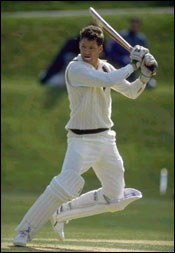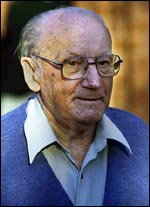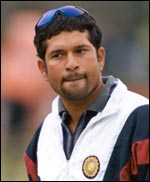Wisden 100
Anantha Narayanan
A lot has been written over the past fortnight on the Wisden 100 list of great innings and bowling analysis in Test matches. We have waited for a while to respond with an explanation, mostly, analytical, of the Wisden-100 list and the methodology.
First. A clarification. This is not a list of the top batsmen or bowlers. It is rather a list of the top innings and bowling performances. It is understandable when the common man makes a mistake of confusing these two totally different types of analysis. It is surprising that only about 25 per cent of the writers have even understood this.
Take a comparison to films. If an objective evaluation of the top 10 Hindi films is done, it is very likely that an Amitabh Bacchan film does not find place in the list. This does not make him to be a lesser star than what he is. He is still, arguably, the greatest ever.
When we developed and fine-tuned the analysis over the past year, we had certain goals and guidelines. We have not deviated from these.
1. I am quite emphatic in my belief that any analysis should be done with the mind, not with the heart. Writing, especially cricket-related, should be written with the heart. Otherwise the writing will seem like a piece ghost-written in a hurry. The analyst should leave subjective, personal and often coloured views for the writers and the writers should leave objective and impersonal interpretations to the analysts. A writer never needs to explain. An analyst almost always has to.
2. We have used only objective, measurable factors. There is no place in an analysis of this magnitude for subjective factors. If 100 knowledgeable people are asked for their list of Top 10 innings ever, it is almost certain that no two lists amongst the 100 will be same.
3. We used only published, verifiable material. This translates to scorecards. This has been done to ensure that the analysis is fair to all the players across years. Also all efforts have been made to ensure objectivity and uniform application across years.
 4. There are many other factors, a few outlined here, such as Dean Jones completely dehydrated (and subsequently hospitalized); Laxman's playing in a perform-or-perish pressure situation; Bradman looking behind his shoulders to see 6 people behind him; Blair batting, knowing that his fiancée had died in a train accident; English players, having won the series, treating the Test match as a practice match; Tendulkar batting with a great personal loss inside him (albeit in an ODI); Graveney batting in temperatures never having experienced before; McCabe playing one of the most courageous innings ever. These factors, amongst others, may have had great impact on players' performances. But these are not measurable, verifiable and most importantly not available for 95 per cent of matches.
4. There are many other factors, a few outlined here, such as Dean Jones completely dehydrated (and subsequently hospitalized); Laxman's playing in a perform-or-perish pressure situation; Bradman looking behind his shoulders to see 6 people behind him; Blair batting, knowing that his fiancée had died in a train accident; English players, having won the series, treating the Test match as a practice match; Tendulkar batting with a great personal loss inside him (albeit in an ODI); Graveney batting in temperatures never having experienced before; McCabe playing one of the most courageous innings ever. These factors, amongst others, may have had great impact on players' performances. But these are not measurable, verifiable and most importantly not available for 95 per cent of matches.
5. We did not and would not expect that the Wisden-100 would find total acceptance with anyone. It should be seen as an objective and fair analysis of 135 years of Test cricket and should stimulate discussion and debate.
One thing we were certain about: we did not want these to be me-too ratings. Reflecting the great name these are associated with, these have to stand the test of time.
Explained below is the basis for calculations, given in sufficient detail.
Batting - Innings rating parameters
1. Batting Base Points: The Batting Base points are given for runs scored.
2. Pitch Index: This index is determined based on the runs scored in a match and number of wickets, which have fallen. Normalizing is done to take care of wide variations. Additional normalization is done to reflect the pre-WW1 situation with uncovered pitches.
3. Bowling Quality Index: The Bowling Quality Index is based on the quality of bowlers who have bowled in the innings. A minimum of 4 and a maximum of 5 bowlers are taken for determining this Index value. Care is taken that the fifth bowler (e-g, Richards) does not lower the Index determination adversely.
4. Percentage of Score Index: This reflects the % of team runs scored by the batsman. Surprisingly, Bannerman's 166 in the first Test ever is still the highest % score in a completed innings.
5. Point of Entry Index: This index reflects the entry point and distinguishes between 5 for 1, 27 for 2, 55 for 1 etc. For the first innings of the Test, the index is absolute. For the other three innings, the Index is linked to a target score, exact for the last innings and notional for the other two.
6. After Point of Entry Index: This index reflects the difference between entering at, say, 10 for 2 with a third wicket partnership of 100 and entering at 10 for 2 and the score going down to 20 for 3/4
7. Wkts falling while at crease Index: This index reflects the number of wickets seen through by the batsman. An opening batsman, carrying his bat through, gets the highest index value.
8. Support Index: This reflects the support received by the batsman or given to other batsman while he played his innings.
9. Shepherding of Tail-enders Index: This index is based on the way the batsman has nursed the 8-11 batsmen and built partnerships. The highest value is given for a batsman who has been involved in 4 significant partnerships.
10. Highest score Index: This is the lowest rated parameter and is given to the innings if the same is the highest for the team.
11. Match Status Index: This is s complex index, which reflects the status of the match. The highest value is given to a successful and close fourth innings chase (Lara's 153*) or a great match-winning innings after a follow-on (Laxman's 281).
12. Result contribution Index: This index is based on the sum of the previous 11 index values and reflects the value of the player's contribution, through the considered innings, to the match result. The match should be a win (x points) or a draw (0.3x points) for this index value to be allocated. Additional weightage is given for away wins.
In addition, most of the Index values, which are calculated, are downsized proportionately if the innings is less than 100.
Bowling - Analysis rating parameters
1. Bowling Base Points: The Bowling Base points are given for Wickets taken.
2. Pitch Index: This index is determined based on the Runs scored in a match and number of wickets, which have fallen. Normalizing is done to take care of wide variations. Additional normalization is done to reflect the pre-WW1 situation with uncovered pitches.
3. Batting Quality Index: The Batting Quality Index is based on the quality of the top 7 batsmen who have played in the innings.
4. Dismissed Batsman Quality Index: This is an important index, which distinguishes between two bowlers who have taken 5 wickets each, the first one, batsmen 1-5 and the second one, batsmen 6-10.
 This is done in two parts. The first is the dismissal itself. The batsman's batting average determines this value. The highest value is given to the bowler who dismissed Bradman and so on.
This is done in two parts. The first is the dismissal itself. The batsman's batting average determines this value. The highest value is given to the bowler who dismissed Bradman and so on.
The second part rewards the timing of dismissal. A bowler who dismisses Richards for a low score will get a higher point value than a bowler who dismisses Srikkanth for the same low value.
5. Bowling Accuracy Index: This index reflects the accuracy of bowling. Spells have to be sufficiently long to get full assignment of this index value.
6. Highest Wickets Index: This is the lowest rated parameter and is given to the analysis if the same is the highest for the team.
7. Match Status Index: This is s complex index, which reflects the status of the match. The highest value is given to a successful, close fourth innings defense (de Villiers' 6 for 43 against Australia).
8. Result contribution Index: This index is based on the sum of the previous 7 index values and reflects the value of the player's contribution, through the considered analysis, to the match result. The match should be a win (x points) or a draw (0.3x points) for this index value to be allocated. Additional weightage is given for away wins.
In addition, most of the Index values, which are calculated, are downsized proportionately if the wickets are less than 3.
Lot has written about the exclusion of any of Tendulkar's innings from the Wisden-100.
Firstly, this list applicable only to Test match cricket and not ODIs. We have analyzed almost all of Tendulkar's Test innings (using the above mentioned data yardsticks). It is our conclusion that Tendulkar has not played many match winning or match saving innings like some of his contemporary batsmen. Many of his quality innings have been played in drawn or lost matches and both his 200s are against weak bowling attacks in drawn matches. However, he has been far more consistent and his average is very high. This is similar to the case of two batsmen, one scoring 100 and 0 in the two innings and the other scoring 60 and 60. Our own internal calculations, based on these Innings rankings, show that, as a batsman, Tendulkar is at the top.
I am going to take only one innings, perceived by many to be the best played by Tendulkar, 155 against Australia at Chennai in 1998, for an analysis. This will also enable the readers to get an insight into the calculation process. There is no doubt that this was a very good innings. It has attained immortality because of the attack he unleashed against Warne. The reasons why this is not very highly ranked are outlined below.
a. The bowling attack (Kasprowicz, Reiffel, Warne (below-par, but this factor is ignored), Robertson (who), Waugh twins and Blewett). This was one of the weakest Australian bowling attacks in recent years.
 b. Two fifties preceded Tendulkar's 100 and one fifty followed. So there was good support.
b. Two fifties preceded Tendulkar's 100 and one fifty followed. So there was good support.
c. Tendulkar came in at 115 for 2 and this was followed by two century stands.
d. There was less pressure on Tendulkar, this being the third innings, not the fourth.
Let us now look at and rejoice in the performances, which have been accorded importance than look only at performances, which have not been accorded the importance.
Laxman's 281 is truly one of the greatest Test match innings ever. It gets its rightful place at No.6 in the Wisden - 100. It is ironic that if he had received less support from Dravid, he might have challenged for the top spot, currently held by Bradman's wonderful tactical masterpiece, 270 against England in 1936. Australia scored 200. On a glue-pot of a pitch, England slumped to 76 for 9 and declared. Australia countered by sending in their bowlers first and was tottering at 97 for 5. Facing Voce, Allen and Verity on an improving, but difficult, pitch, Bradman added 346 with Fingleton and turned the course of the match and series.
Brian Lara's match-winning masterpiece of 153 not out on the last day against Australia's famed attack is in the second position. A lot has been written about this innings. I was one of the many who sat through 6 hours of edge-of-the-bed televised excitement portraying Test cricket at its best. A single mistake by Lara would have been the end of the heroic run-chase. The support was minimal. The captain led from the front and stayed on until the target was reached.
An innings, which has largely gone unnoticed, is in the third position. The place is the minefield at Headingley. The year, 1991. The opposing bowlers, the fearsome quartet of Marshall, Ambrose, Walsh and Patterson. England starts the third innings ahead by 25 runs. Gooch holds center stage for 7 hours. He opens the batting and carries his bat through for 154, made out of 252. The next highest score is 27. Later, the English bowlers win the match comfortably for them.
Kumble's 10 for 74 was one of the greatest moments in Test cricket. It would have displaced Tayfield's performance at the top position if there had been more pressure on India and Kumble. India had set Pakistan to score 420 for a win and won very comfortably. The only reason Tayfield's 9 for 113 finished ahead was the closeness of the contest and the low total which South Africa defended. England was left to score 232 to win, was strongly placed at 147 for 2 when Tayfield produced a wonderful spell of sustained off-spin bowling to dismiss England for 214, South Africa winning by 17 runs. The pressure on him was intense.
The third best bowling analysis is Laker's 10 for 53 at Manchester in 1956. An innings win for England with no Australian resistance lowers Laker's position to No.3.
A final note on Harbhajan Singh. 4 of his recent spells have been placed in the Wisden - 100. This is primarily because these have come in batting-dominated Tests (Overall RPW figures for the two tests being 40.1 and 34.5 respectively) won by India. The fourth performance is at No.100 and is likely to go off the list in the near future.
People have asked about my own Top 10. This list is generated with a combination of heart and mind since it is a personal list. Only 5 out of the Wisden-100's top 10 find place in this list. The list is given, not in any particular order.
Bradman's 270 against England
Laxman's 281 against Australia
Lara's 153 no. against Australia
Lara's 213 against Australia
McCabe's 232 against England
McCabe's 187 no. against England
Gavaskar's 221 against England
Botham's 149 against Australia
Gooch's 154 against West Indies
Hanumant Singh's 94 against Australia in 1964 at Madras.
The last entry deserves an explanation. That was the first Test watched by me. India had to score 332 to win against a very good Australian attack led by McKenzie and Hawke. India lost Jaisimha to the first ball and Indrajitsinhji in the next over. Hanumant Singh walked in at 24 for 4 and plays one of the greatest defiant innings ever, shades of Laxman's 167 at Sydney 35 years later. He scores 94 out of 145. This innings is embellished with 18 fours, most of which are in the 120 degrees from Midwicket to Cover. We lost badly, but what an innings. If there had been a Wisden-5000, I doubt whether it would have found a place. But then my heart, not my mind, has selected that innings. Even Hanumant Singh might have forgotten the innings, but not I.
If I had been allowed 5 more entries, Tendulkar's 155 at Chennai and Steve Waugh's 200 at Kingston would have found a place.
The author runs Hallmark Software, which provides Wisden Online with a range of cricket related services, prominent of which are ratings related. He can be contacted at hallmark@vsnl.in.
More Columns
Mail Ananth Narayanan